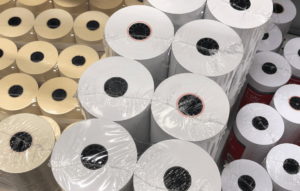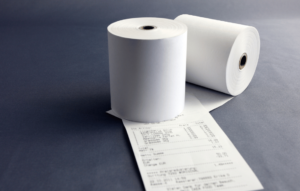Nearly every day, we handle receipt paper without a second thought – tucking it into our wallets, tossing it into bags, or simply discarding it without a glance. This seemingly harmless transaction, however, may carry hidden risks that most of us are unaware of. The culprit? Bisphenol A, commonly known as BPA, is a chemical compound that has found its way into countless consumer products, including the thermal paper used for receipts.
BPA is an endocrine disruptor, meaning it can interfere with our body’s hormone systems, leading to a range of potential health issues. While many of us are aware of BPA’s presence in plastics and food containers, fewer realize that handling receipt paper can be one of the most significant sources of exposure to this toxic chemical.
In this blog, we’ll explore how receipt paper contributes to BPA exposure, look into the health risks associated with it, and examine the trends and solutions emerging in response to this growing concern. Whether you’re a concerned consumer or someone looking to minimize your exposure to harmful chemicals, understanding the risks of BPA-laden receipt paper is a crucial step in safeguarding your health.
Understanding BPA and Its Prevalence
Bisphenol A, or BPA, is a synthetic chemical that has been a staple in manufacturing for decades. It’s mostly used to produce polycarbonate plastics and epoxy resins, which are then used to make a wide assortment of consumer products. From water bottles and food containers to the linings of canned goods, BPA is incredibly pervasive in our daily lives. Its popularity stems from its ability to enhance the durability and clarity of plastics, making them both sturdy and transparent.

However, BPA’s widespread use comes with significant concerns. The chemical is known for its ability to mimic estrogen, a hormone that plays a critical role in regulating various bodily functions. By mimicking estrogen, BPA can disrupt the body’s hormonal balance, leading to a host of potential health problems. This endocrine-disrupting property has made BPA a focal point of scientific research and public health discussions.
Why BPA is Concerning
The main concern with BPA lies in its capacity to interfere with the endocrine system. The endocrine system is a network of glands that produce hormones, which regulate essential processes such as growth, metabolism, and reproductive functions. When BPA enters the body, it can bind to estrogen receptors and either mimic or block the natural hormone’s actions. This disruption can lead to a range of health issues, including reproductive problems, developmental disorders, and an increased risk of certain cancers.
Studies have shown that even low levels of BPA exposure can have significant effects, particularly during critical periods of development such as pregnancy and early childhood. The chemical’s ability to cross the placental barrier and accumulate in the developing fetus raises additional concerns about its impact on future generations.
Given its potential risks, many consumers are now more aware of BPA in products like plastic containers and canned foods. However, few realize that a simple daily act like handling a receipt can result in substantial BPA exposure, making thermal paper a significant, yet often overlooked, source of this chemical.
Receipt Paper as a Major Source of BPA Exposure
Receipt paper may seem like an unlikely source of chemical exposure, but the reality is quite different. Most receipts we receive from stores, ATMs, and gas stations are printed on thermal paper, a type of paper that doesn’t require ink. Instead, it relies on a coating that reacts to heat to produce text and images. The key component in this coating is often BPA, which acts as a color developer during the thermal printing process.
This method of printing makes BPA highly concentrated on the surface of the paper, allowing it to be easily transferred to anything it touches – including our skin. Unlike BPA in hard plastics or resins, which is typically bound within the material, the BPA on thermal paper is in a free, unbound state, making it much more likely to transfer upon contact.
Direct Exposure Through Skin Contact
The ease with which BPA can transfer from thermal paper to skin has been demonstrated in multiple studies. When you handle a receipt, especially for extended periods or multiple times a day, the BPA on the surface of the paper can be absorbed through the skin. This is particularly concerning because, once absorbed, BPA can enter the bloodstream and start interacting with the body’s hormone systems almost immediately.
Research has shown that frequent handling of receipts can lead to elevated levels of BPA in the body. For example, a study conducted by the Environmental Working Group found that people who frequently handle receipts, such as cashiers, have significantly higher levels of BPA in their bodies compared to those who rarely handle receipts. This raises important questions about the cumulative impact of such exposure, especially for individuals who aren’t even aware of the risks.
Occupational Risks
For those who work in environments where handling receipts is a daily task, the risks associated with BPA exposure are heavy. Retail workers, cashiers, and others in similar roles are exposed to potentially harmful levels of BPA on a regular basis. Over time, this repeated exposure can lead to a buildup of the chemical in the body, increasing the likelihood of adverse health effects.
Studies have documented that cashiers often have higher BPA levels in their urine compared to the general population. This occupational exposure not only affects their health but also underscores the need for greater awareness and protective measures in workplaces where thermal paper is regularly used. Given the growing body of evidence linking BPA exposure to health risks, it is clear that the simple act of handling receipts is more hazardous than most people realize.
compared to the general population. This occupational exposure not only affects their health but also underscores the need for greater awareness and protective measures in workplaces where thermal paper is regularly used. Given the growing body of evidence linking BPA exposure to health risks, it is clear that the simple act of handling receipts is more hazardous than most people realize.
The Health Risks Associated with BPA Exposure
Hormonal Disruption
The most significant concern about BPA exposure is the potential for disrupting the body’s hormonal balance. As an endocrine disruptor, BPA can interfere with the normal functioning of key hormones, particularly estrogen. This disruption can have wide-ranging effects on health, particularly in sensitive populations such as pregnant women, infants, and those with hormonal imbalances.
BPA’s estrogen-mimicking properties can lead to reproductive health issues, including infertility and conditions like polycystic ovary syndrome (PCOS). In men, BPA exposure has been linked to reduced sperm quality and other fertility problems. For women, BPA can contribute to menstrual irregularities and may increase the risk of hormone-related cancers, such as breast and ovarian cancer. The chemical’s ability to bind to estrogen receptors means it can disrupt the delicate hormonal balance necessary for healthy reproductive function, leading to a cascade of potential health issues.
Increased Cancer Risk
BPA exposure has also been associated with an increased risk of certain types of cancer. Research has suggested that BPA’s ability to mimic estrogen can promote the growth of hormone-sensitive cancers, particularly breast and prostate cancer. The concern is that BPA, by acting like estrogen, can stimulate the growth of cancerous cells in tissues that are responsive to hormones.
cells in tissues that are responsive to hormones.
Several studies have found correlations between BPA levels in the body and the development of breast cancer. Similarly, prostate cancer has been linked to higher BPA exposure, particularly in men with occupational exposure to the chemical. While more research is needed to fully understand the mechanisms at play, the existing evidence is strong enough to warrant serious caution, particularly when it comes to frequent and prolonged exposure.
Impact on Children and Pregnant Women
The effects of BPA exposure are especially concerning for children and pregnant women. During pregnancy, BPA can cross the placental barrier, exposing the developing fetus to the chemical. This is particularly worrisome because fetal development is a critical time for hormone signaling, and any disruption during this period can have long-term consequences.
Studies have linked prenatal BPA exposure to a variety of developmental issues, including behavioral problems, cognitive deficits, and an increased risk of birth defects. In children, BPA exposure has been associated with developmental delays, early puberty, and changes in behavior such as increased aggression or anxiety. These findings highlight the vulnerability of young children and developing fetuses to the harmful effects of BPA.
Given these risks, it is crucial for pregnant women and parents to minimize BPA exposure as much as possible. This includes being cautious about handling receipt paper, which is a surprisingly significant source of this toxic chemical. As awareness grows, so too will the demand for safer alternatives and protective measures to reduce the impact of BPA on public health.
Emerging Trends, Regulations, and Practical Steps to Reduce BPA Exposure
Consumer Awareness and Demand for BPA-Free Alternatives
As awareness of the dangers associated with BPA has grown, consumers have increasingly demanded safer alternatives in everyday products, including receipt paper. This demand has prompted many retailers and businesses to seek out BPA-free thermal paper as a safer option. However, it’s important to note that while “BPA-free” is a step in the right direction, it doesn’t always mean that the product is free from harmful chemicals. Often, BPA is replaced with Bisphenol S (BPS) or other similar compounds, which may pose similar risks to health.
The market for BPA-free products has expanded significantly, with more companies adopting alternatives that do not rely on bisphenols. This shift is driven not only by consumer demand but also by increasing regulatory pressures in various countries. However, the effectiveness of these alternatives in reducing health risks remains a topic of ongoing research and debate.
Regulatory Actions and Legislation
In response to the growing body of evidence about BPA’s risks, various governments have started to take action. Some countries have banned or restricted the use of BPA in certain products, particularly those aimed at infants and children, such as baby bottles and sippy cups. However, regulations specifically targeting BPA in thermal paper have been slower to develop.
In the European Union, for instance, BPA has been banned in thermal paper used for receipts and tickets since 2020. In the United States, several states have introduced regulations aimed at reducing BPA exposure, though federal action remains limited. These legislative efforts reflect a growing recognition of the need to protect public health from the pervasive exposure to BPA, particularly from sources like receipt paper.
Practical Steps to Reduce BPA Exposure from Receipt Paper
While regulatory changes are an essential part of the solution, there are also practical steps that individuals can take to minimize their exposure to BPA from receipt paper:
- Limit Contact with Receipts: Whenever possible, opt for digital receipts instead of paper ones. Many retailers now offer the option to have receipts emailed or texted to you, which can significantly reduce your direct contact with BPA-laden thermal paper.
- Proper Handling and Storage: If you do need to handle receipts, try to do so briefly and store them in a way that minimizes contact with other items. For example, keep receipts in a separate envelope or plastic bag, rather than directly in your wallet or pocket.
- Wash Hands After Handling Receipts: To reduce the amount of BPA that gets absorbed through your skin, wash your hands thoroughly after handling receipts, especially before eating or touching your face.
- Use Personal Protective Measures: For those who handle receipts frequently, such as cashiers and retail workers, wearing gloves can provide a barrier that prevents BPA from transferring to the skin. Additionally, consider advocating for BPA-free receipt paper in your workplace to protect not only yourself but also your colleagues.
- Safe Disposal: When disposing of receipts, do so in a way that minimizes environmental contamination. Avoid recycling receipts, as BPA can leach into recycled paper products. Instead, dispose of them in regular trash to prevent further spread of BPA.
By taking these practical steps, individuals can reduce their exposure to BPA from receipt paper, contributing to better long-term health. At the same time, continued advocacy for stronger regulations and safer alternatives is essential to addressing the broader issue of BPA exposure in our daily lives.
Final Thoughts
So yes, the seemingly simple act of handling a receipt can have significant implications for your health due to the presence of BPA in thermal paper. With growing evidence linking BPA exposure to a range of health issues – from hormonal disruption and increased cancer risk to developmental problems in children – it’s clear that minimizing contact with BPA-laden products is absolutely crucial. By staying informed, adopting safer habits, and advocating for better regulations, we can protect ourselves and future generations from the unnecessary hazards of BPA exposure.








